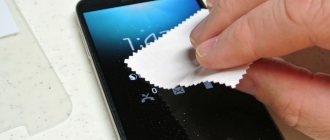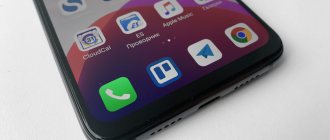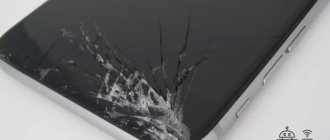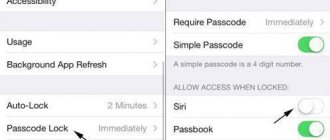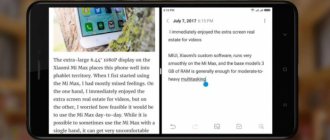Who is responsible for screen locking?
The proximity sensor is responsible for locking the iPhone during a call. Its operating principle is as follows:
It is very simple to check the operation of the proximity sensor: if, when connecting to a subscriber, you cover the part of the phone above the display with your finger, the screen will go dark. There are no proximity sensor settings on iOS; you cannot disable it. That is, it either works properly or does not function due to some kind of error, software or hardware.
How to set up a screen lock on iPhone during a call
Garik Recently noticed that my iPhone screen does not go dark during a call. You can accidentally press something with your cheek or ear. How to turn off the display during calls?
If your iPhone has been jailbroken, the problem may be in the installed tweaks and their settings. If the device has not been hacked, then the likelihood of a software failure is too small. There is no way to intentionally turn off screen fading during a call.
Initially, the system turns off the display when the smartphone approaches something. A sensor located above the auditory speaker is responsible for this.
To check, you can try restoring iOS via iTunes (without downloading a backup) and make a few calls. If the screen still does not turn off, there is a problem with the proximity sensor.
Sometimes the sensor stops working after sticking a film on the display. The protective layer may not have special holes for the sensor to work, it may be too thick, or debris may get between the film and the display.
In such cases, the sensor may not work correctly; its operation should be checked without a protective coating.
If after such a check the screen does not go off during a call, you will have to contact the service center.
Source
Causes of the problem
Among the most common causes of the problem are:
Most often, it is possible to detect and fix the problem on your own, but if we are talking about poor-quality repairs and non-original parts or damage due to mechanical stress and water ingress, then you need to contact a service center. In order not to worry about the quality of repairs and the parts used, choose authorized service centers - it will be more expensive, but you won’t have to redo everything all over again.
Important: when the speakerphone is turned on, the display should not go dark. The sensor is triggered only when talking through the speaker.
The proximity sensor on the iPhone does not work, reasons?
Determining the cause of a malfunction without preliminary testing is quite problematic. After all, the problem may be a software malfunction or physical damage. We will list the most common causes of the malfunction.
Malfunction of the replaced iPhone screen - as a rule, this problem occurs when the screen breaks and is incorrectly replaced. Let's imagine a situation: you dropped your iPhone, it was without protective glass and its screen was very cracked. You have a desire to replace it, but after learning how much it costs to replace it at Apple and how long it will take, you give up this idea and decide to replace it yourself.
And here, you may encounter two problems that you most likely won’t even know about. First, you can buy a cheap, low-quality screen that doesn't support half the functionality of the original iPhone screen. And second, you may not connect it correctly.
Physical damage is a fairly common problem. Try to remember how long ago the proximity sensor stopped working, whether you dropped your iPhone at that time or exposed it to moisture. If yes, then most likely this is the reason. The only way out of this situation is repair from Apple.
checking iphone proximity sensor
Buying a broken smartphone – Apple is one of the largest companies in the world, with a huge number of customers and it becomes a responsibility to produce a quality product. However, this does not mean the absence of marriage. In any production, people are responsible for quality control, and they tend to make mistakes. If you receive a defective iPhone, contact an Apple service center as soon as possible.
Software malfunction - sometimes the problem may be a buggy iOS update or incorrect installation of an application. Solving this problem is quite easy, but you risk losing all the files on your smartphone.
Troubleshooting
The first thing to do is to rule out the possibility of a system failure that prevents the sensor from functioning normally. If the iPhone screen lock works intermittently during a call, perform a hard reset. It will help eliminate non-critical errors in the system.
On iPhone 7 and other models without a physical Home button, another combination is used - Power + Volume Down key.
If the problem is not resolved after a hard reset, reset your settings and content. Be sure to back up your iPhone so you don't lose any personal information. After resetting your device, do not rush to restore it from a backup. First, set up your iPhone as new, check if the sensor works, and then return the settings and files that were on the phone before the reset.
If resetting the settings does not solve the problem, pay attention to the smartphone screen. Does it have film, glass, or a case that covers the top of the device? Remove all accessories from the display and test the sensor again. Perhaps the film, glass or case prevents the waves from passing through, and without them the screen will again be blocked perfectly.
When a hard reboot, resetting settings, removing film and other measures do not help, there is only one way left - to the service center. Something bad has probably happened to the sensor and needs to be replaced. The procedure is quick and inexpensive, but necessary if you want to get rid of screen lock problems.
The screen does not turn off when talking on the iPhone - what is the reason?
Your device has a sensor that detects how close the phone is to your face.
It is called a proximity sensor. It forces you to temporarily turn off the screen during a phone call when the smartphone is placed to your ear. This prevents other features on your smartphone from being unintentionally enabled. The photo sensor is located on the front of the phone (above the screen). It may take up to a few seconds for this sensor to activate the function, but usually much less.
If the screen does not go dark when talking on your iPhone, then the proximity sensor is not working as expected. Here are some main cases:
- It is possible that the user did not remove the thin temporary film that initially covers the touch screen when purchasing a new device (the so-called “transport film”). It is very easy to visually identify such a coating - it has a small tail protruding from one side.
- If your device has an additional screen cover, make sure that this protective glass is specified for the specific smartphone model you are using. It is important that the clear cover has the appropriate holes for the proximity sensor and front camera in the correct positions. To check the exact location of the proximity sensor for your iPhone model, consult your user manual.
- You can view the appearance of the device on the official Apple website.
- Check to see if the photocell is dirty, touched by greasy fingers, or stuck to any debris, chewing gum, etc. Many problems with the light sensor can be resolved simply by cleaning it.
- If you use a case (such as a book or bumper) that does not fit the phone well (i.e., slightly larger), this may affect the functionality of the detector. The sides of the protective case may extend slightly onto the screen and block the sensor's clearance.
- Force restart your phone. Perhaps the system is simply frozen and slows down, which causes incorrect operation.
- Check the functionality of the proximity sensor on your phone using appropriate test applications, of which there are a huge number in official sources.
- Pay attention to the battery charge of your mobile device. A lack of power may cause various phone features, including the proximity sensor, to not work properly.
- Make an additional copy of all important data saved on your smartphone, then perform a factory reset.
Do not remove the thin anti-reflective coating installed by the manufacturer (present on almost all types of Apple smartphones).
Try these methods one by one if the screen does not turn off when you are on a call on your iPhone. After each attempt, check to see if the problem was resolved before trying another method.
If the screen still does not go off when talking on the iPhone, contact the manufacturer via the official website of the iPhone manufacturer or the nearest branded service center. If you need to return your device for service or warranty, back up all data that you want to keep.
Also, delete all available information such as accounts, social networks, banking applications and e-wallets that are on the device before sending the phone for repair. Be sure to provide proper documentation, such as proof of purchase and warranty card. If the smartphone is still under warranty, this will help save significant funds.
The display does not go dark after notifications
Another similar problem is that the screen lights up when a notification about a message or other event arrives, and then does not go off. If this happens at night, then by morning you can get a well-discharged smartphone. The problem is unpleasant, but you can solve it yourself, without contacting a service center. For this:
If this does not solve the problem, think back to when the problem first appeared. Uninstall the latest games and applications, if you jailbroken and installed tweaks - pay close attention to them. Jaybreaking, by the way, may also be the reason why the proximity sensor stops working during calls, so be careful about hacking the system.
If you can't find a specific app or tweak that's interfering with iOS, perform a hard reset, reset settings and content, and then set up your iPhone as a new device.
Source
Disabling a module
If, on the contrary, you are wondering: “How to disable the proximity sensor on an iPhone,” then you can use one of the following methods:
- Download the Smart Screen Off app. The program allows you to calibrate and adjust the moments of switching on and off.
- Dial the combination “* # * # 0588 # * # *” - a software shutdown method built into the depths of the iOS operating system by engineers.
- Disassembling the smartphone and removing the proximity sensor is perhaps the most radical way.
Why doesn't my iPhone screen turn off during talk time?
If during a conversation the display reacts to touching it with your face or ear, then the gadget has a hardware or software malfunction with the proximity sensor. It is he who is responsible for turning off the screen. It can still be seen at a certain lighting angle next to the hearing speaker.
The proximity sensor is located next to the front camera and speaker
Reasons why the iPhone screen does not lock during a call? some:
The problem also often occurs in devices that were sent in for repair to replace the screen. Most likely the technician simply forgot to connect it or did it incorrectly.
Note! A faulty proximity sensor also prevents you from using the Siri voice assistant.
You can check the operation of the sensor during a call by creating an obstacle in front of its lens at a distance of a couple of centimeters
The screen does not turn off when talking on iPhone - what to do
The first step is to check how the sensor works:
If the screen does not go off, then the problem is really in the sensor. Here it’s worth remembering another possible reason – incorrect auto-lock settings. Usually the user does not need to look there, but if it is the work of malware, then it is worth downloading an antivirus.
To understand that the iPhone does not turn off during a conversation due to the settings, you need to:
Activate the slider if for some reason it is not enabled. After this, you should additionally reboot and try again to check the screen lock during a call.
iPhone 5s screen does not turn off when talking
Based on the above reasons why the screen does not go dark when the iPhone is talking, all that remains is to sort through the options, taking into account the most frequent requests from owners.
As for 5th generation iPhones, including S and SE, most often the problem lies in the cases. Today you can find absolutely any “exclusive” case for a top five. Often it is he who applies the sensor described above, and it stops turning off the screen during a call.
Also, in the case of this model, it is worth checking the protective glass (if any). Due to the age of the gadget, the market is flooded with accessories that were not produced in accordance with Apple standards.
When installing protective glass on the iPhone screen, you need to make sure that it will not cover the sensor
The screen does not go dark when talking on iPhone 7
Starting with iPhone 7 and 7 Plus, the user can diagnose sensor failure independently:
After this, following the system prompts, make sure that the sensor is faulty.
If buttons are pressed while talking on your iPhone, how to fix the situation is worth mentioning a forced reboot. On iPhone 7 it works like this:
But in truth, this method rarely helps.
Does not turn off in talk mode on other models
If the proximity sensor does not work correctly on the iPhone XR, X, XS, 8, 8 Plus, you should make sure that there are no updates. For new iPhones, unlike the same fives, this is an important factor in the normal functioning of the entire filling.
Note! Due to recent user complaints about errors when updating gadgets to iOS 13, you should activate iCloud backup before starting the procedure.
How to reset settings on iPhone
What to do if the proximity sensor on your iPhone doesn't work?
The proximity sensor in the iPhone is one of the main elements of the phone. It is needed for:
- adjusting the display backlight during calls;
- to dial a number;
- to enable the Siri voice service;
Accordingly, users cannot use all of the above functions if the proximity sensor on the IPhone does not work. The constantly backlit screen during a call is a particular inconvenience. Due to a non-working sensor, buttons and icons are pressed, which can interrupt the call.
Causes of malfunction
A non-working sensor may be due to:
- mechanical damage (due to a fall or impact of the iPhone);
- train wear;
- Excessive amounts of dust getting on the sensor;
- moisture getting into the phone case. In this case, you should disassemble the phone and dry all the display components separately;
- Problems after firmware update.
Note! In some cases, the inactivity of the sensor may occur due to the cover that covers it. A poor-quality protective glass may also interfere with the proximity sensor's operation.
Firmware rollback
Often a problem with the sensor appears after installing updates. Developers do not always have time to fix all the bugs. If you do not want to wait for a new firmware version with a solution, you can roll back the OS to the previous version. Follow the instructions to return to the previous OS version:
- connect your device to your PC and open the iTunes application;
- Hold down the Shift key on your personal computer and at the same time click on “Restore iPhone”. In the OS X operating system, you need to hold down the Alt button;
- Select the most recent backup. Wait until the components are installed. It will take no more than 40 minutes.
The sensor stopped working after replacing the display - solution
If you changed the iPhone screen and after that the proximity sensor stopped working, this indicates that the position of its frame was violated. As a result, the sensor cannot perform its function. You can correct the position of the element yourself. Disassemble the phone (use only tools designed for iPhone - picks, pentagonal screwdriver, suction cup, Phillips screwdriver, spudger). Unfasten the back cover of the device, first disconnecting all cables from the motherboard.
Find the proximity sensor holder:
Remove the sensor frame and reinstall it. Remember, the element must be located exactly in the frame of the case.
A correctly installed frame is shown in the figure:
Replacing a cable in an iPhone
Thanks to the instructions described below, you can replace a non-working sensor yourself. Before purchasing a new cable, pay attention to its markings. The original product contains digital and symbolic codes, QR codes and inscriptions of the manufacturer with the corresponding symbols. A genuine iPhone cable looks like this:
As a rule, a breakdown can only be corrected by replacing the cable part. It contains the phone's front camera and proximity sensor mechanism. Unfasten the back cover from the iPhone display module and begin replacing the part.
Place the module on a flat surface and unscrew the screws shown in the figure:
Disconnect the top speaker cover and then the speaker itself.
Using a spudger, disconnect the front camera and proximity sensor cables.
Using tweezers, carefully remove the sensor (painted in purple tint) from the cable and replace it with a new part. You can also replace the entire cable.
You can find any instructions for self-repairing an iPhone on our website, or arrange a call to a specialist at any place convenient for you.
It often happens that the proximity sensor in iPhone 5s, iPhone 6, iPhone 7, iPhone 7 plus, etc. does not work due to physical damage.
Then you will need to replace it, and for this you need to know where it is located in your iPhone.
As you already know, it determines whether there is a physical object in the immediate vicinity of the iPhone.
Some types actually have the ability to change the distance to an object, but phones at this stage do not have such functionality.
In general, they have high reliability and a long service life, but still, cases where they fail are not isolated.
Note! The proximity sensor in an iPhone is sold together with a cable and often also with a camera - as in the picture above.
What to do if the screen does not lock when talking on your iPhone
If all of the above tips have not led to success, and the screen on the iPhone still does not go dark during a conversation, then all that remains is to contact the service center. The great news is that specialists will easily replace the sensor itself if it breaks down. Or they will put the cable back in place if it became disconnected during a fall.
If the user purchased an iPhone from an official retailer within a year or two, he has the right to free service if the cause of the sensor failure falls under the terms of the warranty case.
According to the law, in Russia the warranty for iPhones is 2 years
What to do if iPhone does not turn on the screen during a call
It’s worth taking a look at how the iPhone display behaves during a call. Especially if there is film or glass glued to the display.
Sometimes the screen may not turn off when the iPhone is brought close to your ear during an active call. Or vice versa, do not turn back on when moving away from your head until the conversation is completed.
There may be several reasons for this, so we will look at each separately.
Software problems
The first step is to exclude the possibility of software failures and errors. You can do this at home, and you will save time while the gadget is in the service center if it turns out that the cause of the malfunction is a breakdown of components.
1. First, make sure you are not using test versions of iOS or developer firmware.
We have already described in detail how to roll back to a stable version of iOS and disable the ability to download beta releases of the system.
2. Reboot your device and try to track down the problem.
Sometimes such glitches disappear after rebooting the gadget or Hard Reset. Read more about how to do this here.
3. Remove applications that are built into standard programs.
Sometimes such failures can be caused by various extensions for Phone (caller ID and call filters), Messages (iMessage add-ons) or third-party keyboards from the App Store.
Remove such programs while checking your smartphone.
4. Disable two important system settings. Incorrect operation of the sensor may be affected by the iOS features “Raise to activate” (Settings – Screen and brightness) and “Open with a finger” (Settings – Universal access – Home button) on iPhone models without Face ID.
Turn off both and check for a glitch.
5. Restore the firmware on the device.
The last way to check the functionality of the software is to reset the device and restore the factory firmware. This way you can get rid of glitches associated with jailbreak or system crashes due to regular over-the-air updates.
You can first try resetting the settings, and then restoring iOS. Detailed instructions are included.
How to fix proximity sensor problems on iPhone?
Remove the case and protective glass
This is perhaps the simplest, but often not very effective method. However, try removing the case and screen protector of your smartphone and test if the problem persists.
Reboot your smartphone
As absurd as it may sound, simply rebooting the iPhone helps eliminate half of the problems. In order to restart your iPhone, you need to:
- Hold the power button for a few seconds until the “Power Off” slider appears.
- Move the slider to the right and wait 2-3 minutes.
- Press the power button until the Apple logo appears on the screen.
Hard Reset
iOS update
Updating the operating system can fix many problems. including the iPhone's proximity sensor not working. With each new update, previous bugs are fixed and performance improves. Sometimes the design is updated and new features are added. In order to update iOS, you need:
Reset
If none of the above methods work, you can reset all settings on your iPhone. This usually fixes iPhone 5, 6, 7 proximity sensor glitches.
In order to do this, you need:
- Open "Settings".
- Tap "Basic".
- Select the “Reset” → “Reset all settings” function. After entering the password, click "Reset all settings" to complete the process.
Reset all data and settings
This method will not only erase all settings, but also all data, including apps, photos, videos, etc. Before you begin, create a backup copy of your data. In order to make a reset, you need:
- Open "Settings".
- Tap "Basic".
- Select the “Reset” → “Reset content and settings” function. Enter your password and then confirm your actions.
iPhone recovery
iPhone proximity sensor not working after update? You may be wondering what the difference is between this and the previous step. After all, both methods erase data and reset all settings. In fact, the difference is not great, but it is there. The recovery process will also format and reinstall the OS.
- Connect iPhone to Mac/PC using a USB cable.
- Make sure you have the latest version of iTunes.
- Open iTunes.
- In the summary tab, click the "Restore" button.
- Next, all that remains is to wait for the procedure to complete.
You can restore using the program. Errors occurred during recovery, list and their correction.
When you attach iPhone 6s, iPhone 5s, iPhone 6, iPhone 4, iPhone 6 plus, iPhone 5, iPhone 4s, iPhone 7, iPhone se, etc. to your ear during a call, the screen turns black.
Thanks to this, there are no problems with pressing unwanted buttons on the touch screen when we are talking on the phone.
Over time, it may happen that the proximity sensor does not work, for example, after an update, although of course there may be other reasons.
Yes, you can replace the broken part, but don't rush it even if you have a new proximity sensor on hand.
Problems with accessories
If all manipulations with the software have not produced any results and the glitch appears with the same frequency, you should proceed to checking the accessories you are using.
1. Get rid of covers and cases.
The first on the list of unsuccessful accessories may be the iPhone case. This is especially true for accessories that cover the screen or the top of the gadget from the front.
The case may interfere with the correct operation of the sensors. This will happen both due to the banal closure of the sensors and due to the presence of magnets in the design of the case.
2. Do not use removable accessories.
Problems with the sensors on the top of the smartphone can be caused by removable accessories such as attached lenses for the camera, an aquabox, or a tripod with a powerful mount.
During testing, avoid such accessories.
3. Remove the glass or protective film.
No matter how much you would like to remove the protective coating from the front panel, it will be removed in any case when checking the gadget at the service center.
Perhaps it is poor quality protection that prevents the proximity sensor from responding correctly.
Hardware problems
If all the described procedures do not give any effect, then the problem is with the iPhone components.
1. The device was damaged due to a fall.
Glitches and failures may not begin immediately after the fall, but after several days or even months.
2. The gadget does not work after poor quality repairs.
If the device was in the hands of craftsmen from a basement service center, something could very well be damaged or connected incorrectly. The cable could have been laid incorrectly, which had become frayed during operation; the module could have been completely forgotten to be secured and over time it moved out and stopped fitting into the corresponding hole.
Why doesn't the iPhone screen lock during calls and what should I do?
Users often encounter the problem that the screen does not lock when talking on the iPhone. The proximity sensor is responsible for locking the iPhone during calls. During a conversation, we bring the phone screen to our ear, thus triggering the proximity sensor.
It turns out that if the iPhone screen does not go dark during calls, then the problem is related to this sensor. If the screen is not locked, the buttons on the iPhone are pressed during a call. This is very inconvenient and many people are annoyed by the involuntary operation of the buttons. In this article we will try to find out what exactly caused this part to fail and how it can be fixed.
Photo: Proximity sensor
How to turn off the screen on iPhone during a call
The most common reason why the screen does not lock during a call may be in the phone settings. If the screen does not lock, then you should check in the Incoming calls menu whether the toggle switch next to the “Proximity sensor” line is turned on.
If the toggle switch in the section is turned off, then the reason that the phone is not blocked may be because of it. To enable the function, move the toggle switch to the “on” position. The same must be done in the “Outgoing calls” section.
If the toggle switch is in the “on” position, then the cause of the failure may be different.
Enable or disable proximity sensor on Android
Typically, the sensor on the device is active by default. If in your case this is not the case, or this function was somehow disabled by accident, then enabling it will not be difficult. This is done as follows: go to “ Settings”
", find the section "
System applications
", select the item "
Phone
":
Then click " Incoming calls"
" and move the slider in the "
Proximity sensor
" line to the active position (on some gadgets you will need to check the box):
Depending on the smartphone model, activating the sensor will look slightly different, for example, by immediately opening the dialing field, call up the call settings menu or by pressing the “ Settings”
", or by pressing and holding the hardware options button.
And after that, as was written above, in “ Incoming calls
” we turn on the sensor:
If the question is about how to turn off the proximity sensor, then, accordingly, we go the same way and deactivate the function (uncheck it).
System failure
Before proceeding with other solutions, you first need to check your iPhone for any system error by scanning with an antivirus. Errors in the operating system result in the iPhone turning off the screen when talking, but not locking it. In this case, the screen does not respond to the phone approaching or moving away from the caller. In other words, a person, for example, tries to perform additional manipulations with the device (turn on the speakerphone), but the phone does not unlock when the device is removed from the face. In this case, you have to unlock it manually.
If there is such a problem, you should fix it, and then check whether the function works or not. If the function still does not work, then you can try to restore the phone, but before doing this, you should try other solutions to the problem, otherwise this will lead to data being deleted from the iPhone.



